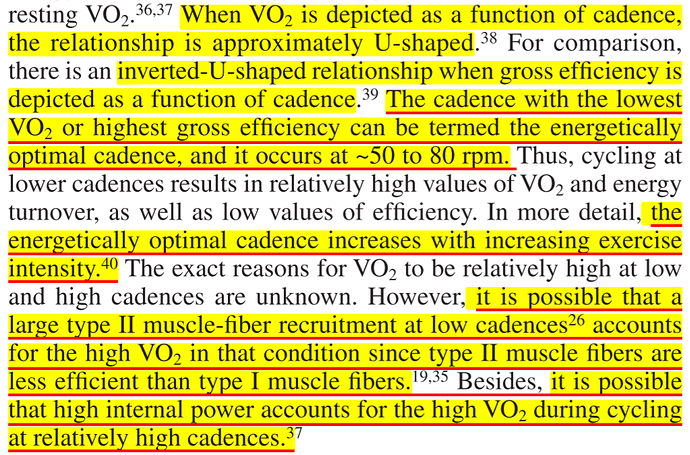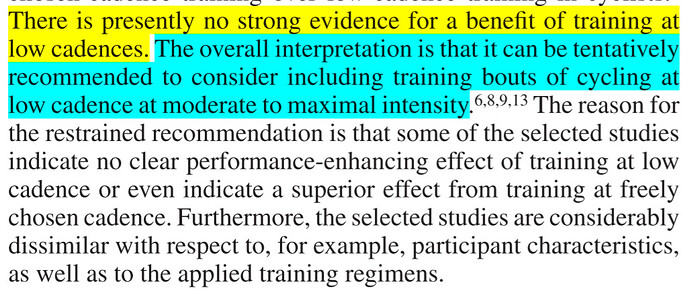I realize that cadence doesn’t seem to be too important when it comes to cycling performance. But it does seem to shift the training load from your muscles (low cadence) to your cardiovascular system (high cadence). So if one is doing Zone 2 (in a 7 zone model) by training to power, does it matter which system is working harder? Or is this a reason to use heart rate as the metric for Z2 endurance training?
Hi @jvbailey88 ,
I find it difficult to answer your question, because you indicate a shift between muscles and the cardiovasculair system. That is a shift that is not possible.
You can produce a constant power with both high and low cadence. In the high cadence option the muscles need to produce less force than in the low cadence option. That is because:
power = cadence * force.
In both options, you are training your cardiovascular system.
If your power output is a 2 out of 7, your heart rate is probably higher in the high candence option.
When your power output is 5 out of 7, the heart rate might be higher in the low cadence version as your type I and type 2 muscles are engaged, and the resulting heat, sweating and full-use of the type I fibers requires a higher heart rate.
HI @jvbailey88,
It’s a really interesting question with a complex answer. There’s a lot of research on the subject and the conclusions are all over the map. We’re actually planning an episode in the spring to address this question - bit of a selfish episode. I really want to read the most recent research on the subject, so doing an episode gives me an excuse.
But, I do fully agree with @kjeldbontenbal that it’s not as simple as one working your muscular system and one working your cardiovascular system. What you will see are small differences in fiber-type recruitment, neuromuscular recruitment patterns and efficiency. It’s been generally accepted that the most efficient cadence is around 60RPM. But again, the research is complex on the subject and a it’s also been shown in elite cyclists that the most efficient cadence is higher and a recent study showed no difference in efficiency across various cadences (I really want to dive into that one because I’m not sure I buy it.)
The one thing that is certain is that in large scale data analysis studies where they looked at the training behavior of top pros, they spent a lot of time doing lower cadence work (and a fair amount of time doing higher cadence work.)
Hope that helps!
Trevor
Great to hear @trevor that a new episode on this topic is in the making.
@jvbailey88 , inspired by @trevor’s response: you can try it for yourself what happens if you alter between low and high cadence every 10 minutes (and well within the duration that you can perform with a fixed intensity)
Thanks all! I did not mean to imply (although I did write it that way) that there was a total shift, but rather that at high cadence the legs muscles are working a little less hard. Question - did you really mean to say that 60 rpm was the most efficient? That seems incredibly low. But I guess when I climb in the 70s rpm range, I have a lower perceived exertion and heart rate than when I climb at a higher cadence. It would be interesting to learn how cadence affects each zone. Also the question of what cadence is the most efficient seems distinct from the question of which cadence is optimal for training.
@jvbailey88, yup, I did mean to say 60 RPM and I’ve actually seen claims that it’s lower. Just keep in mind that the most efficient cadence isn’t necessarily the best cadence. If you’re in the middle of the peloton riding at 55 RPM and someone attacks, so how quickly you’re able to respond. You may be efficient, but you’re going to lose the race.
This is why pros still train high cadences and what I’ve seen in the research is that because of all of this work, pros are more efficient at much higher cadences.
@trevor , is there any evidence out there to suggest that different cadence can lead to different level of fatigue during/after the ride? i.e. case 1: cyclist rides at 150W for 4 hrs at 60 rpm vs case 2 cyclist rides at 150W for 4 hrs at 95 rpm.
As a scientist (microbiologist) I know anecdotes don’t count for much, but as a cyclist, I’d be willing to bet $5 that if I did this test on the trainer, the pool of sweat under me would be larger under Case 1, and my legs would hurt worse under Case 2. Which of these extremes (or some intermediate cadence) would provide me with the better training stimulus? I have no idea.
There is quite a lot of evidence that shows that cadence meaningfully affects the O2 cost of power output (cycling economy, W/L/min VO2) and therefore total energy expenditure and fatigue, albeit this probably hasn’t been demonstrated explicitly out to 4+ hrs, to my knowledge. As a consequence, CP is lower at higher cadence; the power associated with LTs, VTs, etc. is lower at higher cadence; Wpeak in a ramp test is lower at VO2peak, etc. Or said another way, the same power output performed at a higher cadence constitutes a higher relative intensity.
There is limited and mixed evidence for whether manipulating cadence in training leads to altered physiological (e.g. VO2peak) and performance (e.g. Wpeak or TT) outcomes. See this recent review.
The consistent findings and recommendations more generally are that more specific training might lead to marginally more specific adaptations, implying in the context of cadence that:
(1) training at the cadence(s) you need to perform at may be marginally more effective
(2) training at a wider range of cadences will probably improve your performance over that range of cadences
(3) specific cadence manipulation matters much less than just doing the work consistently! Just going for those two 4-hr 150 W rides matters far more than what cadence they are performed at ![]()
Trevor can probably speak more about this
edit: right, I thought I posted more information somewhere here recently:
It’s not a scientific answer and it does not meet the point of the question - but I would like to bring in that zone 2 rides are a great opportunity to play arround with cadence. And in my perception it’s beneficial for developing better technique when it comes to pedalling in general. That is what I had to do when I was a junior cyclist by order of our coaches. And today as a masters athlete I am very thankful for that …


